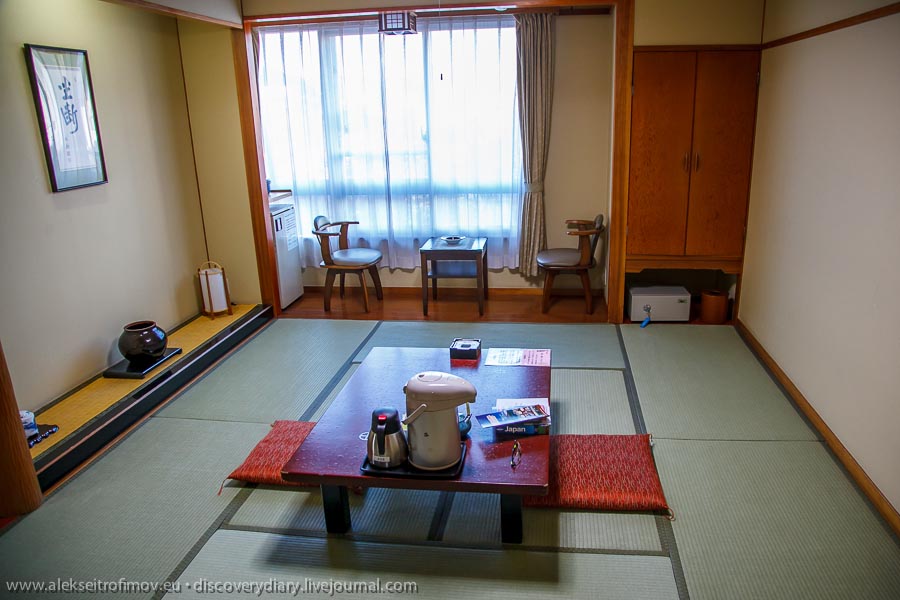This post is about the experience of staying at a real ryokan in Kagoshima, which included an onset bath as well as a kaiseki-style dinner.
Let me start though by describing what kinds of hotels exist in Japan.
The theory of Japanese hotels
There are two main types of hotels in Japan: business hotel and ryokan.
Business hotel
Business hotel is reminiscent of a small and rather impersonal Western hotel. As a rule, the room in such a hotel will be very small, but fitted like a LEGO toy with a whole list of items, which is quite invariable. There are things that you would expect in a hotel: a usual bed, a TV, a small table where you can work on a computer (internet surprisingly tends to be provided by a cable modem, in-room wifi is rare).
Every Japanese business room, no matter how small, will also always have:
– a hair dryer;
– flashlight;
– three bottles (soap, shampoo and conditioner);
– a small disposable toothbrush with a minuscule tube of toothpaste;
– a small disposable hairbrush.
As a rule you will also have an en-suite bathroom, very small, which would include a bath tub as well as a technological miracle called “Japanese toilet”, which will often have a heated seat as well as a special tube that comes out to wash and dry your intimate parts.
Traditional ryokan
The other type of the Japanese hotel is called ryokan. This is a completely different style of accommodation. The rooms in a ryokan will be somewhat bigger, but will have virtually no furniture to which we are used to. The floor is covered with tatami mats. The walls are represented by sliding partitions from wood and paper. Oftentimes the bathrooms are shared. The ryokan room will not have a chair, but rather a low seat as well as a low table, you are meant to sit essentially on the floor. Instead of a bed you sleep on a special Japanese mattress (futon), which is put directly on the floor. When it is not used, the futon is kept in a cupboard behind a partition. It is not all that convenient to sleep on a futon, in fact it’s quite hard, so I found it tiring to stay in ryokan all the time – and consequently interchanged ryokans and business hotels, to experience both comfort and tradition.
As Japan is essentially four volcanic islands, she possesses quite a number of hot springs. Ryokan is often built right next to a spring and includes an onsen. An onsen is a Japanese bath. The focus of an onsen is the hot water bath, filled with the water straight from the spring, often very hot indeed.
Ryokan can differ significantly in terms of class. I described above the simple ryokan. High class ryokan will be quite different. It will have large rooms, sometimes with a view to a private garden, which you can admire while meditating in your room. You might have a private bathroom. You don’t have to open and close the futon yourself, the personnel will do it for you. Of course there will be an onsen in such a ryokan. And finally – most pleasantly – a high class ryokan will include an elaborate breakfast and dinner service in the kaiseki style, the high style of Japanese cuisine.
The Japanese consider several days in a high class ryokan the best possible vacation. Already from my last trip I really wanted to stay in such a ryokan if only for a couple of days. However it turned out rather complicated. The minimum price for such a stay is 100 dollars, often it is several times more. But whatever the price, in November and December Japan experiences the peak of the tourist season, and the best ryokan are booked out for many weeks in advance! You also have to take into account the fact that as the ryokan experience involves a whole unwritten etiquette, not every ryokan will agree to accept a foreigner, as the owner might not speak English and might find it stressful to deal with a foreigner. Particularly one travelling solo: the tariffs in ryokan are traditionally per person, rather than per room.
Often you can only get in touch with ryokan by emailing or faxing them – they are not present in the usual reservation systems such as booking.com. You could also call, but bette speak Japanese then. Finally after a number of failed attempts I found a ryokan in Kagoshima which met my specifications and was ready to accept me.
My room:

Continue reading Ryokan Onsen Kaiseki →